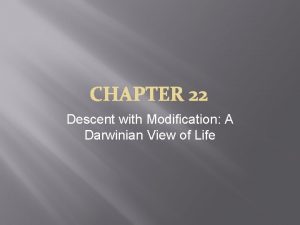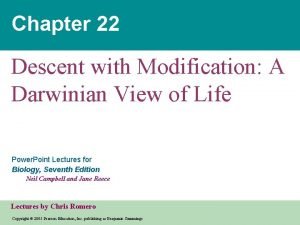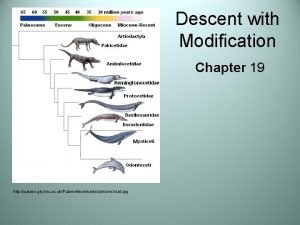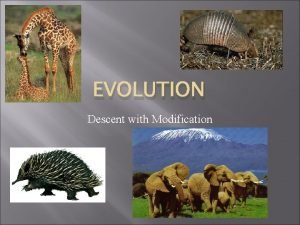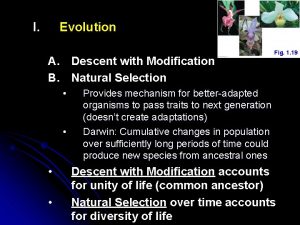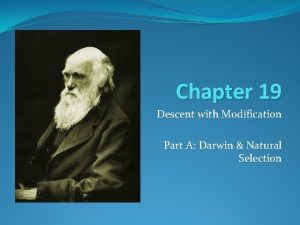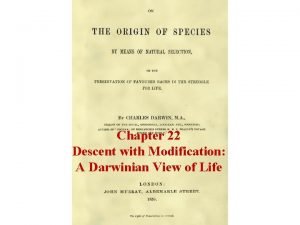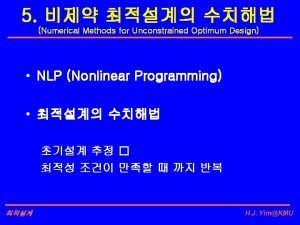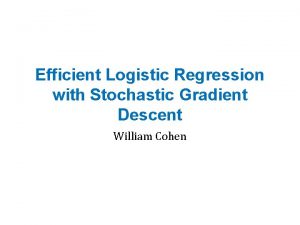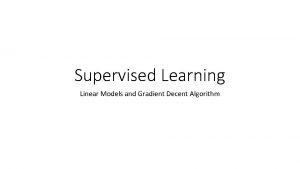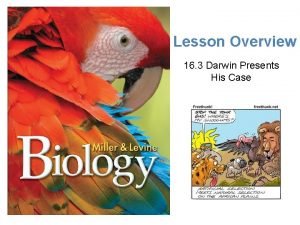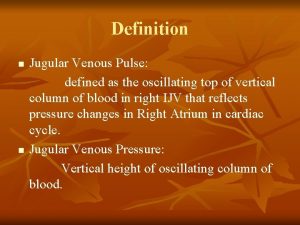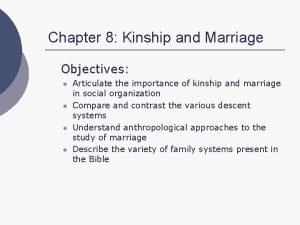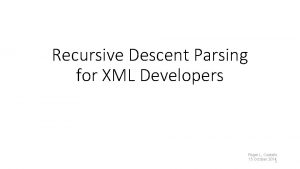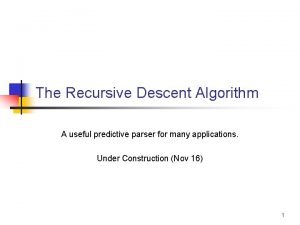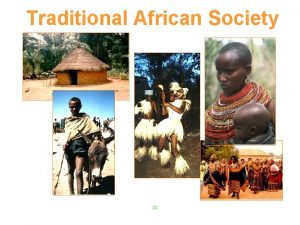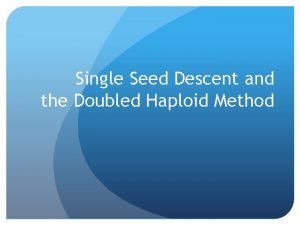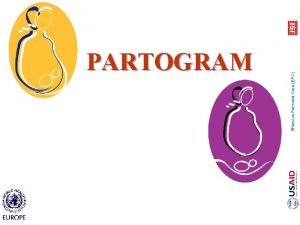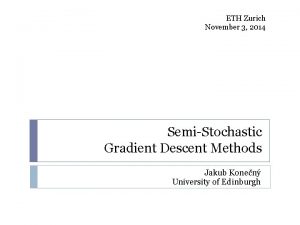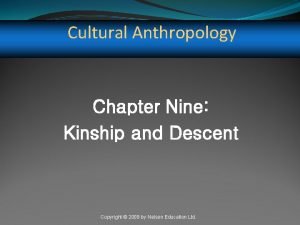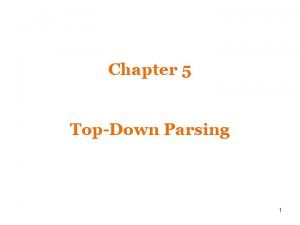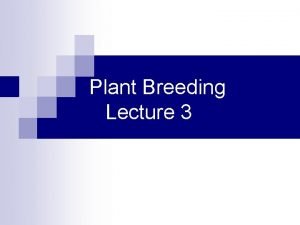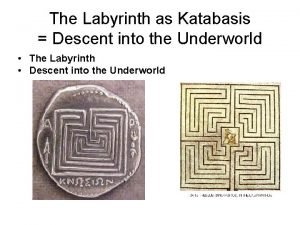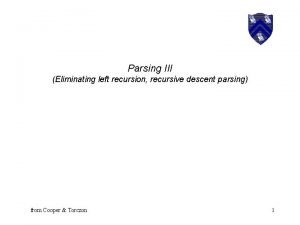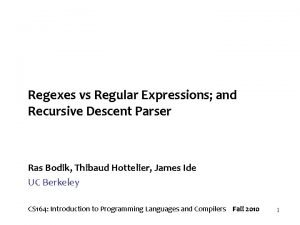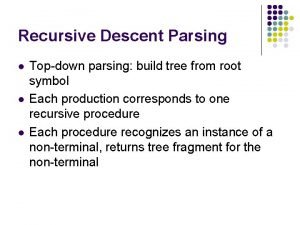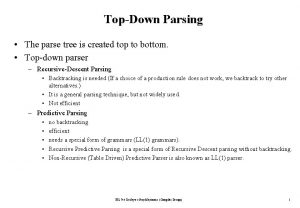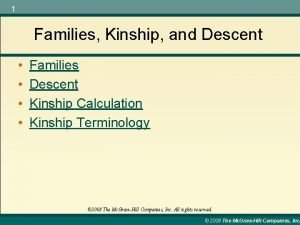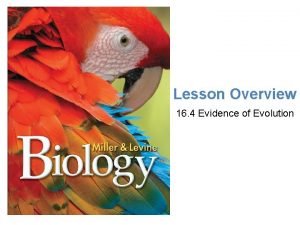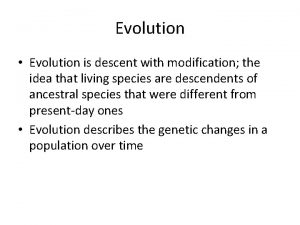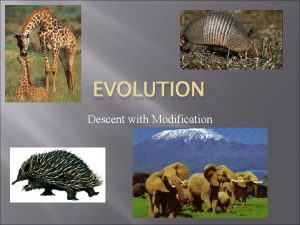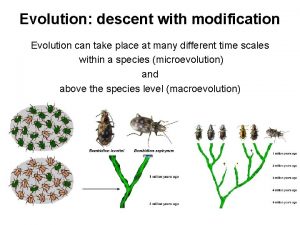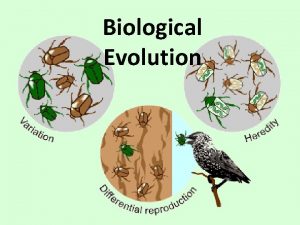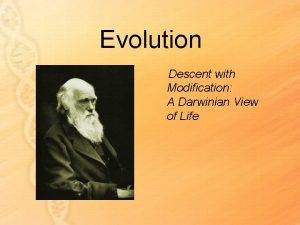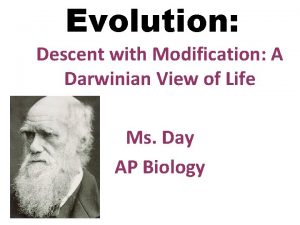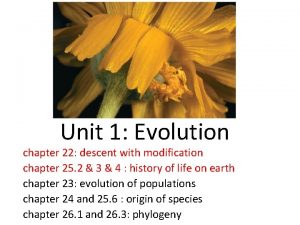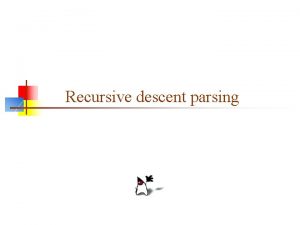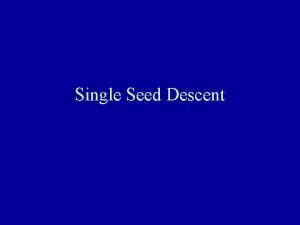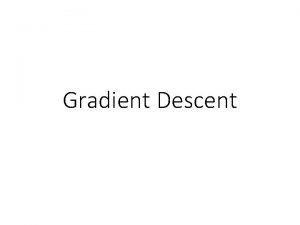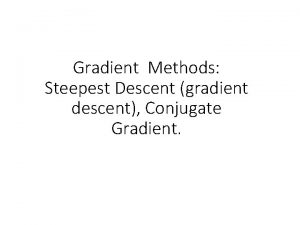Descent with modification Application to the evolution of























































- Slides: 55

Descent with modification: Application to the evolution of development Homologous characters are derived (with modification) from a common ancestral character Both structure and function of homologous traits are evolving away from the ancestral trait The concept of homology can be applied to developmental mechanisms and the genes that control them We need to identify homologous developmental pathways in divergent taxa, and to trace the evolution of their organization and function Three levels of homology in development Homologous genes? Homologous structures? Homologous developmental processes?

Homeotic mutants in Drosophila Homeosis is a replacement of a body part with another, apparently normal body part (W. Bateson, 1894) In Drosophila, homeotic mutants re-specify “segment identity”

HOX genes and axial patterning - Transcription factors with a highly conserved DNA-binding domain (the “homeobox”) - Regulate expression of distinct sets (? ) of target genes - Expressed in distinct but usually overlapping domains along the anteriorposterior body axis in all Metazoans - Organized in (usually) uninterrupted clusters - The order of genes in the HOX cluster is (usually) the same as the order of their expression domains along the AP axis (collinearity)

The homeobox is a highly conserved DNA-binding domain HOX 4 homeodomain Drosophila Amphioxus Mouse Human Chick Frog Fugu Zebrafish

HOX genes control axial patterning in all Metazoans

Axial patterning in the vertebrate brain

Evolution of HOX clusters in Bilateria

Evolution of tandem gene clusters Gene duplication by unequal crossing-over Divergence of coding and regulatory sequences

The complement of HOX genes continues to evolve

Evolution of HOX clusters in vertebrates - Vertebrates have multiple HOX clusters - Paralogous Mouse Fugu HOX genes may have partly redundant functions - Some genes and clusters become specialized for distinct functions - Different lineages lose some genes and acquire new functions for others Zebrafish

New HOX genes for new segmental morphologies? Ed Lewis'es model 1978

The entire HOX cluster pre-dates Arthropod radiation

HOX genes and the Proximo-Distal axis of the vertebrate limb

HOX genes acquire new functions

HOX gene expression boundary coincides with a morphological transition

HOX gene expression boundary coincides with a morphological transition

HOX gene expression boundary coincides with a morphological transition

HOX domain boundary coincides with a morphological transition - Segment homology can be traced across all Crustaceans - Segment and appendage morphology is highly variable in Crustacea - HOX expression domain in different Crustaceans are NOT homologous - The boundaries of HOX domains often coincide with morphological transitions

HOX domain boundaries and morphological transitions Thorax/ Abdomen Gnathal/ Thoracic Poison claw/ walking legs Stalk/ opisthosoma ?

Hox. C 6 and the cervical/ thoracic boundary Hindlimb The number of cervical metameres is different, but the Hoxc 6 always marks the cervical/ thoracic boundary

HOX genes in a highly modified organism Stellate ganglia - a novel structure Brachial crown Combinatorial code?

Descent… All Metazoans possess homologous HOX clusters Individual HOX genes are highly conserved HOX genes control A-P axial patterning in all Metazoans The role of HOX genes in axial patterning is a Metazoan (or at least Bilaterian) synapomorphy … with modification The complement of HOX genes is different in different taxa Orthologous HOX genes are not always expressed in homologous domains Orthologous HOX genes do not always specify homologous structures HOX genes are not linked to specific morphologies or cell types; rather, they provide abstract spatial information HOX genes may be recruited for new functions in structures that have no homologs in other taxa What allows the HOX genes to retain their ancient strategic function, and yet have a different specific role in each context?

Hox genes act by regulating multiple target genes Ubx- regulated

HOX genes specify abstract spatial information Ubx provides the distinction between the forewing and the hindwing in all insects - but this distinction is different in each case

The more things change, the more they stay the same HOX genes regulate the expression of multiple target genes Different HOX genes have distinct (but sometimes overlapping) sets of downstream targets These sets of target genes change during evolution, leading to changes in HOX gene functions and to acquisition of new roles The expression of HOX genes in distinct axial domains serves as the conserved backbone of a developmental mechanism, while the more peripheral aspects of that mechanism continuously evolve We still know very little about the downstream targets of the HOX genes

HOX genes and developmental homology - HOX clusters are homologous across Metazoa - The Anterior-Posterior body axis is also homologous in all Metazoa - Specification of regional domains along the AP axis by HOX genes is a homologous developmental mechanism in all animals in which it is found However, these three levels of homology are dissociable and to a large extent independent

Homologous genes Transcription factors/ selectors HOX genes ey/ Pax 6 Dll/ Dlx cd/ Cdx otd/ Otx Axial patterning Eye development Appendage development Hindgut Anterior brain Signaling pathways dpp/ TGF hh/ Shh wg/ Wnt Notch

The functions of Notch signaling Drosophila Bristle development Dorso-ventral patterning in the wing Ommatidial cell fates Leg joint formation A-P patterning of larval epithelium Vertebrates Neuronal and glial cell development Auditory hair cells Somitogenesis T lymphocyte fates Left-right asymmetry Chondroblast specification Patterning feather primordia There are many more signaling events that there are signaling pathways!

The functions of HOX genes Drosophila A-P patterning of: ectoderm CNS muscles visceral mesoderm Vertebrates A-P patterning of somites and CNS P-D axis of the limbs Reproductive tract Hair follicle development Homologous genes often function in non-homologous structures.

Engrailed functions in Drosophila segmentation

engrailed expression in Arthropods Flea Cricket Crustacean

engrailed & Wnt expression in Annelids Helobdella Platynereis

A common origin of segmentation in Protostomes?

Was the last common Bilaterian ancestor segmented? Amphioxus neurula

A closer look at segmentation in the leech - In early development, en is only expressed in a few clones in each segment -At later stages, segmental stripes form by cell rearrangement -The cells that express en in the segmental stripes are not always clonally related to the early en-expressing cells - This suggests that en is not required for segmentation, but acts after the segments are already established

Phylogenetic distribution of segmentation Segmented ancestor is very unlikely…

Distal-less specifies distal appendage fates in Drosophila

Dll also specifies distal appendage fate in spiders RNAi dac staining

Lobopodia and parapodia Onychophoran Polychaete

Legs, tube feet and ampullae Mouse Ascidian Sea urchin

Homologous developmental pathway for Proximo-Distal axis specification?

eyeless/ Pax 6: a “master regulatory gene” for eye development

Pax 6 expression in the presumptive eye field Mouse Amphioxus Photoreceptive neurons Frontal eye precursor cells Pigment spot

Pax 6 in the Cephalopod eye Photoreceptors Lens Iris Cornea Olfactory epithelium

eyeless/ Pax 6 expression in diverse Metazoans

Conservation of the eye regulatory network Gene Drosophila Vertebrates Otd/ Otx Photoreceptor cells Neural retina Photoreceptor cells ey/ Pax 6 Eye imaginal disc Lens placode, optic vesicle Photoreceptor and pigmented eye cells toy Eye imaginal disc So/ Six 3 Eye imaginal disc, photoreceptor cells, optic lobes Optix/ Six 6 Eye imaginal disc Rx Opsin Flatworms Eye precursor and photoreceptor cells Optic vesicle, neural retina, retinal epithelium Retinal cells Photoreceptors Photoreceptor cells

Eye evolution from a common ancestral organ?

Differences in eye structure between animal phyla Vertebrate Arthropod Cephalopod Arcoid

Similar adult organs, but radically different development

Some differences between vertebrate and arthropod eyes Vertebrates Arthropods Optics Single front element Compound Origin of photoreceptors CNS Epidermis Orientation of photoreceptors Inverse Everse Photoreceptor structure Ciliary Microvillar Secondary messenger c. GMP ITP Mechanism of light detection Membrane hyperpolarization Membrane depolarization

Developmental homology and dissociation. Part I. Homologous genes need not function in the development of homologous structures (HOX genes, Notch signaling) Expression of a homologous gene does not imply that developmental pathways are also homologous (engrailed and metamerism) Homologous developmental pathways may control the development of non-homologous structures (Dll in appendages, Pax 6 in the eyes)

Segmentation of the Drosophila embryo

Genetic control of segmentation in Drosophila

Pair-rule gene expression in grasshopper Drosophila Tribolium eve ftz

Homologous genes need not function in the development of homologous structures Expression of a homologous gene does not imply that developmental pathways are also homologous Homologous developmental pathways may control the development of non-homologous structures Developmental homology and dissociation. Part II. Homologous structures need not be specified by homologous genes (insect segmentation)
 Descent with modification darwin
Descent with modification darwin Descent with modification
Descent with modification Descent with modification: a darwinian view of life
Descent with modification: a darwinian view of life Chapter 19 descent with modification
Chapter 19 descent with modification Is this true
Is this true Chapter 22: descent with modification
Chapter 22: descent with modification Descent with modification definition
Descent with modification definition Descent with modification definition
Descent with modification definition Chapter 22 descent with modification
Chapter 22 descent with modification Carolus linnaeus
Carolus linnaeus Chapter 22 descent with modification
Chapter 22 descent with modification Chapter 22: descent with modification
Chapter 22: descent with modification Areas of application of behavior modification
Areas of application of behavior modification Single seed descent
Single seed descent Tracing family descent through mothers rather than fathers
Tracing family descent through mothers rather than fathers Common descent
Common descent Linear regression with multiple features
Linear regression with multiple features Gradient descent java
Gradient descent java Gradient descent equation
Gradient descent equation Common descent
Common descent Internal jugular vein
Internal jugular vein Neck veins waves
Neck veins waves Ambilineal descent
Ambilineal descent Limitations of recursive descent parser
Limitations of recursive descent parser Recursive descent parser
Recursive descent parser Brachistochrone
Brachistochrone Griots
Griots Single seed descent
Single seed descent Partogram examples
Partogram examples Absent y descent
Absent y descent Identical by descent vs identical by state
Identical by descent vs identical by state Gradient descent rule
Gradient descent rule Kay ousterhout
Kay ousterhout Double descent anthropology
Double descent anthropology Uil skin form
Uil skin form The work done by gravity during the descent of a projectile
The work done by gravity during the descent of a projectile Recursive top down parser
Recursive top down parser Plant breeding
Plant breeding Heracles katabasis
Heracles katabasis The left recursion produces
The left recursion produces Stochastic gradient descent
Stochastic gradient descent Quickest descent
Quickest descent Lord of the flies descent into savagery
Lord of the flies descent into savagery Visual descent point
Visual descent point Recursive descent parser
Recursive descent parser Recursive descent parser
Recursive descent parser In panic mode recovery of ll(1) parsing ___________
In panic mode recovery of ll(1) parsing ___________ Batch gradient descent
Batch gradient descent Nltk recursive descent parser
Nltk recursive descent parser Vda jeppesen
Vda jeppesen Ambilineal descent
Ambilineal descent Partograph
Partograph Texas descent and distribution before 1993
Texas descent and distribution before 1993 Basilosarus
Basilosarus Fetal descent stations
Fetal descent stations Linear regression gradient descent
Linear regression gradient descent

